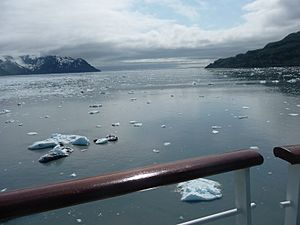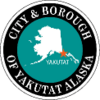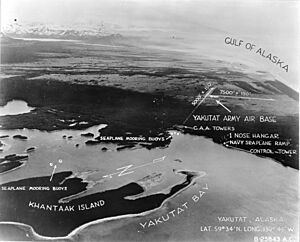Yakutat, Alaska facts for kids
Quick facts for kids
City and Borough of Yakutat
Yaakwdáat
|
|||
|---|---|---|---|
|
Home Rule Borough
|
|||
|
Shore of Vitus Lake
Cape Suckling
Disenchantment Bay
USCGC John F. McCormick at the Hubbard Glacier
Cabin at the Italo River in Tongass National Forest
|
|||
|
|||

Map of Alaska highlighting Yakutat City and Borough
|
|||
| Country | United States | ||
| State | Alaska | ||
| Founded | 1903 | ||
| Incorporated | September 22, 1992 | ||
| Borough seat | Yakutat | ||
| Area | |||
| • Borough | 7,623 sq mi (19,744 km2) | ||
| • Urban
(CDP)
|
104.1 sq mi (269.6 km2) | ||
| • Land (CDP) | 100.5 sq mi (260.3 km2) | ||
| • Water (CDP) | 3.6 sq mi (9.3 km2) | ||
| Elevation | 112 ft (34 m) | ||
| Population
(2020)
|
|||
| • Borough | 657 | ||
| • Estimate
(2022)
|
700 | ||
| • Density | 6.6/sq mi (2.53/km2) | ||
| • Urban
(CDP)
|
657 | ||
| • Urban density | 6.311/sq mi (2.4369/km2) | ||
| Time zone | UTC–9 (Alaska (AKST)) | ||
| • Summer (DST) | UTC–8 (AKDT) | ||
| ZIP Code |
99689
|
||
| Area code(s) | 907 | ||
| FIPS code | 02-99282 (borough) 02-86490 (CDP) |
||
| GNIS feature ID | 1415858, 1419986 | ||
| Sales tax | 5.0% | ||
The City and Borough of Yakutat (pronounced YAK-uh-tat) is a special kind of county in Alaska. It's called a borough. The name comes from the Tlingit language, Yaakwdáat, which means "the place where canoes rest." This name was influenced by an older Eyak word and the Tlingit word for "canoe."
Yakutat is huge! It's about six times bigger than the state of Rhode Island. This makes it one of the largest county-like areas in the entire United States. In 2020, about 657 people lived there. It is one of Alaska's least populated boroughs.
The Borough of Yakutat was officially formed on September 22, 1992. Before that, Yakutat was a city within a larger census area. Today, the main town of Yakutat is considered a "census-designated place" (CDP). Another small community in the borough is Icy Bay, which has an airport.
Contents
History of Yakutat

The first people to live in the Yakutat area were likely the Eyak people. Later, the Tlingit people moved into the region. The Eyak and Tlingit cultures blended before Europeans arrived in Alaska. Yakutat was one of many Tlingit and mixed Tlingit-Eyak villages. Over time, other villages became empty or were left behind.
Early European Contact
In the 1700s and 1800s, explorers from England, France, Spain, and Russia visited the area. A Russian company built a fort in Yakutat in 1795. They wanted to trade with the Native Alaskans for valuable sea otter furs. This settlement was known as New Russia. However, the Russians stopped the Tlingit people from fishing nearby. Because of this, a Tlingit war party attacked and destroyed the fort in 1805.
Yakutat in the United States
After the Alaska Purchase by the United States in 1867, people started mining for gold on the black sand beaches around 1886. In 1889, the Swedish Free Mission Church opened a school and a sawmill in the area.
Around 1903, the Stimson Lumber Company built a cannery (a factory for canning fish), another sawmill, a store, and even a railroad. Many people moved to the current site of Yakutat to work at the Stimson cannery, which operated until 1970.
During World War II, the U.S. Army Air Forces built a large air base near Yakutat. They also built a paved runway. The troops left after the war, but the runway is still used today as Yakutat Airport. It offers regular airline flights.
Modern Yakutat Economy and Culture
Today, fishing is the biggest economic activity in Yakutat.
The Yakutat Tlingit Tribe (YTT) is working hard to keep the Tlingit language alive. They received grants to teach the language to young people and adults. They use fun, interactive ways to teach, like "Total Physical Response."
A photographer named Seiki Kayamori took many pictures of Yakutat and its surroundings from 1912 to 1941. He worked at a local cannery. The Yakutat City Hall has a large collection of his photos.
The Yakutat and Southern Railway used to operate in the area. It carried fish from canneries to the harbor. This train service stopped in the mid-1960s.
Geography of Yakutat

The Yakutat borough covers a total area of about 9,463 square miles (24,510 km²). Most of this is land, but a large part is water. The main town of Yakutat is located at the mouth of Yakutat Bay. It's in a remote area along the Gulf of Alaska, about 212 miles (341 km) northwest of Juneau.
Yakutat shares borders with the Gulf of Alaska to the west. It also borders other parts of Alaska, British Columbia in Canada, and the Yukon Territory in Canada.
Natural Wonders and Protected Areas
The borough includes parts of several beautiful protected areas. These include Chugach National Forest, Glacier Bay National Park, and Tongass National Forest. It also has parts of Wrangell-St. Elias National Park and Preserve.
A very special feature in Yakutat is Hubbard Glacier. It's North America's largest tidewater glacier, meaning it flows directly into the ocean. In 1986 and 2002, the glacier grew so much that it blocked the entrance to Russell Fjord. This created a huge lake called Russell Lake. The lake's water level rose many feet until the ice dam broke. Scientists watch this glacier closely because if Russell Lake gets too high, its water could spill into the Situk River. This would greatly affect the river's important fish populations.
Yakutat's Climate
Yakutat has a cool, wet climate. It gets a lot of rain and snow, making it one of the wettest places in the United States. On average, it receives about 140 inches (3.5 meters) of precipitation each year. This rain and snow falls on about 240 days of the year! The snowiest months are November through April. September and October are usually the rainiest months.
The temperatures in Yakutat are generally cool. The average daily temperature ranges from about 28.6°F (-1.9°C) in January to 55.4°F (13.0°C) in July. It rarely gets extremely cold or hot.
| Climate data for Yakutat, Alaska (Yakutat State Airport), 1991−2020 normals, extremes 1917−present | |||||||||||||
|---|---|---|---|---|---|---|---|---|---|---|---|---|---|
| Month | Jan | Feb | Mar | Apr | May | Jun | Jul | Aug | Sep | Oct | Nov | Dec | Year |
| Record high °F (°C) | 58 (14) |
56 (13) |
60 (16) |
71 (22) |
80 (27) |
87 (31) |
85 (29) |
88 (31) |
77 (25) |
66 (19) |
59 (15) |
61 (16) |
88 (31) |
| Mean maximum °F (°C) | 44.5 (6.9) |
46.1 (7.8) |
49.5 (9.7) |
59.2 (15.1) |
68.0 (20.0) |
72.7 (22.6) |
71.7 (22.1) |
71.5 (21.9) |
65.5 (18.6) |
56.1 (13.4) |
48.4 (9.1) |
46.0 (7.8) |
77.0 (25.0) |
| Mean daily maximum °F (°C) | 34.8 (1.6) |
37.8 (3.2) |
40.0 (4.4) |
46.9 (8.3) |
53.7 (12.1) |
58.8 (14.9) |
61.6 (16.4) |
61.8 (16.6) |
56.9 (13.8) |
48.9 (9.4) |
40.1 (4.5) |
36.4 (2.4) |
48.1 (9.0) |
| Daily mean °F (°C) | 28.6 (−1.9) |
30.6 (−0.8) |
32.0 (0.0) |
38.6 (3.7) |
45.6 (7.6) |
51.9 (11.1) |
55.4 (13.0) |
54.7 (12.6) |
49.4 (9.7) |
41.9 (5.5) |
33.7 (0.9) |
30.8 (−0.7) |
41.1 (5.1) |
| Mean daily minimum °F (°C) | 22.4 (−5.3) |
23.5 (−4.7) |
23.8 (−4.6) |
30.3 (−0.9) |
37.6 (3.1) |
45.0 (7.2) |
49.2 (9.6) |
47.5 (8.6) |
41.9 (5.5) |
34.8 (1.6) |
27.1 (−2.7) |
25.1 (−3.8) |
34.0 (1.1) |
| Mean minimum °F (°C) | 1.1 (−17.2) |
5.8 (−14.6) |
7.0 (−13.9) |
19.0 (−7.2) |
28.2 (−2.1) |
35.1 (1.7) |
41.5 (5.3) |
37.5 (3.1) |
29.8 (−1.2) |
22.3 (−5.4) |
11.2 (−11.6) |
7.0 (−13.9) |
−3.1 (−19.5) |
| Record low °F (°C) | −22 (−30) |
−20 (−29) |
−20 (−29) |
3 (−16) |
9 (−13) |
29 (−2) |
35 (2) |
29 (−2) |
16 (−9) |
6 (−14) |
−10 (−23) |
−24 (−31) |
−24 (−31) |
| Average precipitation inches (mm) | 12.41 (315) |
10.29 (261) |
9.52 (242) |
7.94 (202) |
7.85 (199) |
5.41 (137) |
7.63 (194) |
13.91 (353) |
19.03 (483) |
18.88 (480) |
13.55 (344) |
13.94 (354) |
140.36 (3,564) |
| Average snowfall inches (cm) | 28.9 (73) |
27.5 (70) |
30.4 (77) |
7.2 (18) |
0.3 (0.76) |
0.0 (0.0) |
0.0 (0.0) |
0.0 (0.0) |
0.0 (0.0) |
3.4 (8.6) |
20.0 (51) |
29.6 (75) |
147.3 (374) |
| Average precipitation days (≥ 0.01 inch) | 20.7 | 18.5 | 18.3 | 18.6 | 16.6 | 16.5 | 18.8 | 19.3 | 21.8 | 23.0 | 21.8 | 23.0 | 236.9 |
| Average snowy days (≥ 0.1 in) | 11.3 | 10.7 | 11.9 | 4.5 | 0.2 | 0.0 | 0.0 | 0.0 | 0.1 | 1.4 | 8.5 | 13.5 | 62.1 |
| Average relative humidity (%) | 82.8 | 83.1 | 81.2 | 81.4 | 82.5 | 84.5 | 87.7 | 88.5 | 89.0 | 87.6 | 84.8 | 84.1 | 84.8 |
| Average dew point °F (°C) | 20.5 (−6.4) |
23.4 (−4.8) |
25.5 (−3.6) |
30.7 (−0.7) |
38.1 (3.4) |
45.0 (7.2) |
49.8 (9.9) |
49.8 (9.9) |
44.8 (7.1) |
37.0 (2.8) |
27.0 (−2.8) |
22.8 (−5.1) |
34.5 (1.4) |
| Source: NOAA | |||||||||||||
People of Yakutat
| Historical population | |||
|---|---|---|---|
| Census | Pop. | %± | |
| 1880 | 300 | — | |
| 1890 | 308 | 2.7% | |
| 1900 | 247 | −19.8% | |
| 1910 | 271 | 9.7% | |
| 1920 | 165 | −39.1% | |
| 1930 | 265 | 60.6% | |
| 1940 | 292 | 10.2% | |
| 1950 | 298 | 2.1% | |
| 1960 | 230 | −22.8% | |
| 1970 | 190 | −17.4% | |
| 1980 | 449 | 136.3% | |
| 1990 | 534 | 18.9% | |
| 2000 | 680 | 27.3% | |
| 2010 | 662 | −2.6% | |
| 2020 | 657 | −0.8% | |
| 2023 (est.) | 687 | 3.8% | |
| U.S. Decennial Census 1990-2000 2010-2020 |
|||
Yakutat first appeared in the U.S. Census in 1880 as a Tlingit-Yakutat village. All 300 people living there were listed as Tlingit. By 1890, the population included Native people, White people, and people of mixed Russian and Native heritage. Yakutat officially became a city in 1948. In 1992, it formed its own borough.
Population Details (2010 Census)
In 2010, there were 662 people living in Yakutat.
- About 50% of the people were White.
- About 40% were Native American.
- A small percentage were Asian or Pacific Islander.
- About 8% were from two or more racial backgrounds.
- Less than 1% were Hispanic or Latino.
It's interesting to note that almost 6% of the people in Yakutat spoke the Tlingit language at home.
The median age in Yakutat was 37 years old. This means half the population was younger than 37, and half was older.
Notable People from Yakutat
- Alexander Andreyevich Baranov (1747-1819): He founded a Russian settlement at Yakutat Bay.
- Alison Bremner: A Tlingit artist born in Yakutat, known for her modern art.
- Byron Mallott (1943-2020): He served as the mayor of Yakutat.
- Martin Sensmeier (born 1985): An actor.
- X'unéi (late 1700s): A chief of the Tlingit people.
See also
 In Spanish: Yakutat (Alaska) para niños
In Spanish: Yakutat (Alaska) para niños











